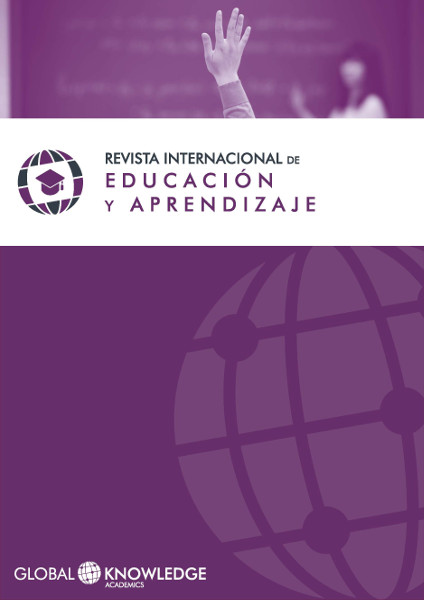M-Learning in the communication model for the academic tutoring process: Case Study
DOI:
https://doi.org/10.37467/gka-revedu.v7.2032Keywords:
Tutorial, Learning Mobile, Mobile Apps, Communication, TechnologyAbstract
This article presents the design, development and implementation of an APP application - named as TUTORAPP to improve the communication process of tutors and students of Upper Secondary Education (high school) within the University of Guadalajara in the state of Jalisco, being the second most important university in México.
Downloads
Global Statistics ℹ️
|
583
Views
|
443
Downloads
|
|
1026
Total
|
|
References
ANUIES. (2004). Programa Institucional de Tutorías. Una propuesta de la ANUIES para las IES. Colección Biblioteca de la Educación Superior, México. 2ª Edición corregida: ANUIES.
Benavides, D. J. (2004). La ética y los medios de comunicación en el ámbito de la cultura publicitaria. Una aproximación conceptual. En Zamora, J.A. Medios de comunicación, información, espectáculo y manipulación. Verbo Divino, Navarra. España.
Campbell, D. & Campell T. (2000). The mentoring relationship: differing perceptions of benefits, en College Students Journal, Vol. 34, núm. 4, pp. 516-523.
Dyzenchauz, G. (2017). 6 Formas en que las Aplicaciones Móviles Mejoran la Comunicación en las Empresas. Obtenido de https://es.linked.com/pulse/6-formas-en-que-las-aplicaciones-m%C3%B3viles-mejora-la-german-dyzenchauz (fecha de consulta:03/03/16).
EPRAM, P. R. (2016). Plan de Acción tutorial. PAT. Ahualulco de Mercado, Jalisco, México: Universidad de Guadalajara.
González, F. (1995). Comunicación, desarrollo y personalidad. Editorial Pueblo y Educación. La Habana, Cuba.
Harris, P. (2001). Going mobile. Learning Circuits. American Society for Training and Development Magazine All Ab out eLearning 2001.
Navarro, G. M. (2010). La labor del tutor con los alumnos de UNAM en el extranjero. Revista Mexicana de Bachillerato a Distancia. México. DOI: https://doi.org/10.22201/cuaed.20074751e.2010.4.29146
López, F., & Silva, M. (2014). M-learning patterns in the virtual classroom. Mobile Learning Applications in Higher Education [Special Section]. Revista de Universidad y Sociedad del Conocimiento (RUSC), 11(1), 208-221. doi http://doi.dx.org/10.7238/rusc.v11i1.1902 DOI: https://doi.org/10.7238/rusc.v11i1.1902
Prensky, M. (2004). What can you learn from a cell phone? http://www.marcprensky.com/writing/Prensky [Fecha de consulta: 09/02/17]
Prensky, M. (2001). Nativos e Inmigrantes Digitales. Obtenido de http://www.marcprensky.com/writing/Prensky [Fecha de consulta: 21/06/16]
Petrovsky A. (2005) Psicología evolutiva y pedagógica. Edit Pueblo y Educación, Ciudadanía de la Habana. Cuba.
Ramos, A.I., Herrera J.A. & Ramírez M.S. (2010). Desarrollo de habilidades cognitivas con aprendizaje móvil: un estudio de casos. Comunicar, 17(34) ,201- 209. DOI: https://doi.org/10.3916/C34-2010-03-20
SEMS, S. d. (2013). La tutoría en el Sistema de Educación Media Superior. Guadalajara, Jalisco: Universidad de Guadalajara.
Tejeda J. & Arias L. (2003) El Significado de Tutoría Académica en Estudiantes de Primer Ingreso a la Licenciatura. Revista de la Educación Superior Vol. XXXVII(3), núm. 127, Julio- Septiembre.
Universidad de Guadalajara, (2011). Programa Institucional de Tutorías (PIT). PIT. Guadalajara, Jalisco, México: Universidad de Guadalajara.
Velázquez, F. & Cuevas, A. (2013). El modelo de acción tutorial basado en la carpeta electrónica del tutor de la Universidad de Guanajuato. Revista DIDAC, (61) 29 -36.
Downloads
Published
How to Cite
Issue
Section
License
Those authors who publish in this journal accept the following terms:
-
Authors retain copyright.
-
Authors transfer to the journal the right of first publication. The journal also owns the publishing rights.
-
All published contents are governed by an Attribution-NoDerivatives 4.0 International License.
Access the informative version and legal text of the license. By virtue of this, third parties are allowed to use what is published as long as they mention the authorship of the work and the first publication in this journal. If you transform the material, you may not distribute the modified work. -
Authors may make other independent and additional contractual arrangements for non-exclusive distribution of the version of the article published in this journal (e.g., inclusion in an institutional repository or publication in a book) as long as they clearly indicate that the work was first published in this journal.
- Authors are allowed and recommended to publish their work on the Internet (for example on institutional and personal websites), following the publication of, and referencing the journal, as this could lead to constructive exchanges and a more extensive and quick circulation of published works (see The Effect of Open Access).













